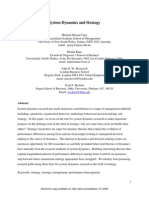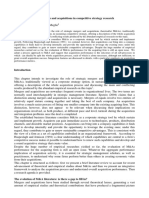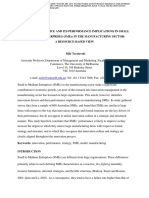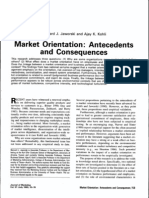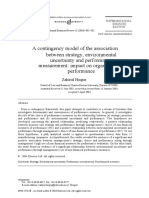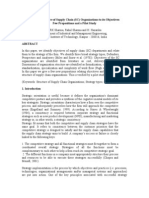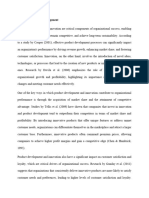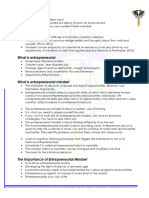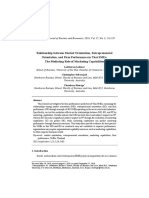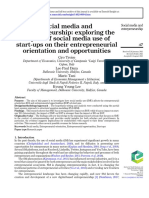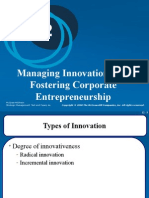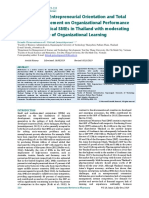Being Entrepreneurial and Market Driven: Implications For Company Performance
Being Entrepreneurial and Market Driven: Implications For Company Performance
Uploaded by
Esrael WaworuntuCopyright:
Available Formats
Being Entrepreneurial and Market Driven: Implications For Company Performance
Being Entrepreneurial and Market Driven: Implications For Company Performance
Uploaded by
Esrael WaworuntuOriginal Title
Copyright
Available Formats
Share this document
Did you find this document useful?
Is this content inappropriate?
Copyright:
Available Formats
Being Entrepreneurial and Market Driven: Implications For Company Performance
Being Entrepreneurial and Market Driven: Implications For Company Performance
Uploaded by
Esrael WaworuntuCopyright:
Available Formats
The current issue and full text archive of this journal is available at www.emeraldinsight.com/1755-425X.
htm
Being entrepreneurial and market driven: implications for company performance
Shaker A. Zahra
Department of Strategic Management and Organization, Gary Holmes Center for Entrepreneurial Studies, Carlson School of Management, University of Minnesota, Minneapolis, Minnesota, USA
Abstract
Purpose The purpose of this paper is to examine empirically the interaction between entrepreneurial orientation (EO) and market orientation and its effect on performance in both high and low technology industries. Design/methodology/approach The paper proposes that being entrepreneurial and market-driven stem from two distinct organizational capabilities that interact to inuence subsequent rm performance. Findings Data from 457 manufacturing rms show that the interaction effect is signicant only in high technology industries. Research limitations/implications The results encourage future research on the nexus of opportunity recognition and entrepreneurial behavior in established rms embedded in organizational routines. Originality/value The paper shows that managers in high technology industries would benet from developing capabilities and implementing systems that augment their rms market orientation. Market orientation provides an important means to harness the rms EO, an important means of achieving growth and protability. Keywords Entrepreneurialism, Market driven production, Market orientation, Organizational performance Paper type Research paper
Entrepreneurial and market driven 125
Over the past two decades, researchers have given considerable attention to revitalizing established companies by infusing entrepreneurship throughout operations (Burgelman and Grove, 2007; Sathe, 2003). Researchers have examined the structural and contextual factors (e.g. environment) that inuence entrepreneurial abilities of these rms (Covin and Slevin, 1989; Lumpkin and Dess, 2001). They have also studied the contribution of entrepreneurship to a rms performance (Keh et al., 2007). Entrepreneurial rms are likely to increase new product development, facilitate new business creation, and reenergize existing operations (Pinchot, 1985). This growing body of research highlights the importance of rms entrepreneurial orientation (EO), reected as a propensity to take risks, to innovate and to be proactive
The author acknowledges with appreciation the contributions of Gerry George to several earlier drafts of this article. An earlier version was presented at the Babson College Entrepreneurship Research Conference. He is grateful for the support of Nikos (the Dutch Institute for Knowledge Intensive Entrepreneurship) and the 3TU Professorship at the University of Twente, The Netherlands. Patricia H. Zahras comments are also appreciated.
Journal of Strategy and Management Vol. 1 No. 2, 2008 pp. 125-142 q Emerald Group Publishing Limited 1755-425X DOI 10.1108/17554250810926339
JSMA 1,2
126
(Lumpkin and Dess, 1996; Green et al., Covin and Slevin, 2008). EO has been linked to key organizational outcomes such as innovativeness, strategic exibility and improved rm performance (Keh et al., 2007; Miller, 1983; Wiklund, 1999; Lyon et al., 2000). Because EO manifests itself differently in different settings and its effects on performance vary from one industry type to another, researchers have called for studies that examine the organizational practices and conditions under which EO improves nancial performance (Dess et al., 1997; Baden-Fuller and Stopford, 1994). Recent parallel developments in the study of organizational capabilities provide an interesting insight into the entrepreneurial process. Some empirical studies capture a rms capabilities to track market changes such as competitor and consumer behavior to help create new products and services. This market-driven capability, referred to usually as market orientation is dened as a rms ability to track and respond to ongoing changes in the marketplace through intelligence generation and information dissemination activities (Im et al., 2008; Jaworski and Kohli, 1993; Keh et al., 2007; Slater and Narver, 1999). This body of literature suggests an overlap between a rms market orientation and its entrepreneurial orientation (Atuahene-Gima and Ko, 2001; Hult and Ketchen, 2001). In this article, we suggest that EO and market orientation reect complementary organizational capabilities, where the routines that support an organizations market-orientation would intensify the relationship between its EO and subsequent nancial performance. Entrepreneurship and strategy literatures have examined how rms adapt to environmental change by recognizing and exploiting the opportunities created by uncertainties as a means of wealth creation (Burgelman and Grove, 2007; Hitt et al., 2001; Sathe, 2003). A key path to opportunity recognition and subsequent exploitation, specically with regard to present and future customer needs, is manifested in a rms market orientation. Market-oriented businesses usually seek to understand customers expressed and latent needs and develop superior solutions to meet these needs (Grinstein, 2008; Im et al., 2008; Kohli and Jaworski, 1990; Slater and Narver, 1995). While some researchers argue that rms with a strong market orientation may over-emphasize current customer needs possibly overlooking future products and growth opportunities (Christensen and Bower, 1996, Connor, 1999), other researchers disagree (Slater and Narver, 1998). Though some studies have addressed this construct, researchers call for further examination of the interaction between market orientation and other organizational processes and its inuence on rm performance (Slater and Narver, 1999; Song et al., 2008; Stam and Elfring, 2008; Wang, 2008). Further, prior studies have not investigated the contingent nature of industry effects on the relationship between EO, market orientation and rm performance. For example, while many high technology industries enjoy high protability, they tend to be high velocity industries that favor agile and proactive strategic choices. Low technology industries, on the other hand, may not always provide opportunities for such rapid growth or high protability (Grant, 1998). High and low technology industries offer contrasting settings that could reveal signicantly different relationships between the rms EO, market orientation and nancial performance. Therefore, this study empirically examines the interaction between EO and market orientation and its effect on performance in both high and low technology industries. The study proposes that a rms gains from EO will be signicantly higher when it
adopts an effective marketing orientation and this effect will be signicantly higher in high technology industries rather than in low technology industries. The remainder of this article is organized as follows. First, we discuss entrepreneurship in established rms. Then, we identify a rms market orientation as reective of an organizational capability that serves to complement its entrepreneurial orientation. Here, we posit that the interaction of entrepreneurial and market orientations would lead to improved nancial performance. Also, we argue that such an orientation would be more salient in technology-intensive industries than in less technology-intensive industries. Subsequently, we present the data and explain the process by which these hypotheses are tested and elaborate upon the ndings and its implications for research and practice. Theory development Entrepreneurial orientation Entrepreneurial opportunities arise from innovation and technological changes, industry upheaval, demographic shifts and macro-economic changes among others (Zahra, 2008). Based on the Austrian economic perspectives, Kirzner (1997) suggests that the discovery of new prot-making opportunities arises from an entrepreneurs alertness to such opportunities rather than a series of accidents of chance. Kirzner notes, an entrepreneurial attitude is one which is always ready to be surprised, always ready to take the steps needed to prot by such motives (1997, p. 72). Therefore, the key to entrepreneurial success is a disposition to alertness for new opportunities and the ability to quickly act upon revealed opportunities (Alvarez and Barney, 2007). Building on Austrian economics, entrepreneurship scholars have advanced frameworks on the sources, discovery, exploitation of entrepreneurial opportunities and their consequences (Kirzner, 1997; Shane and Venkataraman, 2000). Empirical studies suggest that the ability to recognize opportunities and act upon them is quintessential to successful nancial performance (Ahuja and Lampert, 2001). Consequently, entrepreneurial rms usually engage in strategic management processes such as planning and environmental scanning that enable them to recognize and exploit emerging growth opportunities (Barringer and Bluedorn, 1999). These organizational processes or routines help rms develop the capability necessary to discover and respond to new market opportunities. Teece, Pisano and Shuen (1997) suggest that rm-specic capabilities can be sources of advantage and the combinations of competences and resources can be developed and deployed to increase economic prots. This theoretical perspective, the dynamic capabilities view, has generated scholarly attention in recent years to explain organizational change, innovation and new market entry (King and Tucci, 2002; Zahra et al., 2006). Dynamic capabilities are change-oriented capabilities that enable corporations to evolve and recongure their resource base to meet evolving competitive scenarios (Amit and Zott, 2001). Organizational capabilities are embedded in rm routines and those routines are a product of the organization as an entire system (Collis, 1994). Organizational capabilities are not only manifestations of observable corporate structures and processes, but also reside in the corporate culture and the network of employee relations that cannot be attributed to or reduced to a single individual (Teece, 1982). In sum, capabilities embedded in rm routines and
Entrepreneurial and market driven 127
JSMA 1,2
128
processes that allow organizations to adapt and evolve to changing competitive needs are considered to be dynamic capabilities (Zahra et al., 2006). Though the entrepreneurship and strategy literatures have tended to evolve somewhat independently of each other, recent efforts suggest an overlap in research domains especially with regard to entrepreneurship in established organizations (Hitt et al., 2001). In established organizations, corporate entrepreneurship researchers have examined venturing and renewal of existing operations by refocusing their efforts (Stopford and Baden-Fuller, 1994). Also, there are elements of theoretical relevance captured by the dynamic capabilities that is clearly applicable to entrepreneurship in established organizations[1]. First, both dynamic capabilities and corporate entrepreneurship emphasize organizational change and renewal (Zahra et al., 2006). Dynamic capabilities stress the importance of organizational routines that comprise rm-specic capabilities and competences in domain areas such as production, marketing or information technologies (Eisenhardt and Martin, 2000). Firms can build anew or renew their routines, skills, and competences over time and this allows organizations to change. Corporate entrepreneurship also reects change from the perspective of innovation that transforms the prole or identity of the organization over time by redening its product portfolio or the market that it serves (Baden-Fuller and Stopford, 1994). The dynamic capabilities perspective is broad-based in its approach and can be applied to the corporate entrepreneurship context. Second, both research streams emphasize performance outcomes. The dynamic capabilities perspective stresses economic rents or protability while the entrepreneurship literature may emphasize venture growth over economic prot (Shane and Venkataraman, 2000). Though some researchers suggest that entrepreneurship is about venture creation, strategic management is about how an advantage is maintained from what is already established and created (Venkatraman and Sarasvathy, 2001). Both research domains emphasize wealth creation particularly in established organizations (Hitt et al., 2001). In established organizations, it is then possible to suggest that being entrepreneurial requires certain dynamic capabilities be embedded in organizational routines that allow rms to continually search, recognize, and exploit new opportunities. Recognition and exploitation of opportunities is the quintessential role played by entrepreneurs (Kirzner, 1979). In established rms, such opportunities may lead to refocusing the organizations value-creating activities (Burgelman and Grove, 2007; Sathe, 2003; Stopford and Baden-Fuller, 1994) that generate subsequent economic returns and maximizes shareholder wealth. In summary, being entrepreneurial in established rms implies that these rms have superior capabilities to seek out and exploit new opportunities. Entrepreneurial alertness involves the ability to see opportunities that others may not perceive in the same situation (Alvarez and Barney, 2007). Such alertness, in established rms, may possibly be developed and embedded within rm routines and processes that allow organizations to change (Zahra, 2008; Amit and Zott, 2001). Therefore, rms that develop capabilities in opportunity recognition and exploitation are likely to generate greater wealth than rms that do not possess such capabilities.
Market orientation as an organization capability Parallel to the evolution of behavioral research in entrepreneurship, scholars have developed the market orientation construct (Im et al., 2008; Laforet, 2008; Day, 1999; Kohli and Jaworski, 1990; Slater and Narver, 1995). An effective market orientation, as portrayed in these studies, consists of three dimensions: (1) an organizational system that allows the rm to track the changes in its markets (intelligence generation); (2) information dissemination within the rm; and (3) responsiveness to the market (Kohli and Jaworski, 1990). Researchers have studied the antecedents, nature, and outcomes of a rms market orientation (Im et al., 2008; Kohli et al., 1993; Laforet, 2008; Narver and Slater, 1990; Wrenn, 1997). As a result, a rm with a strong market orientation is likely to understand its customers needs, both expressed and latent, and address those needs with the intention of creating superior customer value. Market orientation reects many of the characteristics of a dynamic capability. There are tangible routines that underlie each dimension of a rms market orientation. For example, intelligence generation includes routines to search and disseminate information within the organization. The sum of these routines allows rms to recognize market opportunities. Though market orientation may be akin to being customer-led (Connor, 1999), marketing researchers disagree (Slater and Narver, 1999). These authors argue that industry and customer foresight are reected in a rms market orientation. That is, rms with high market orientation recognize not only customers unsatised needs but also recognize industry trends and competitor actions. Therefore, market-oriented rms have developed underlying organizational routines and processes that allow them to track market changes and predict evolving customer needs. Some studies report that market orientation is a signicant predictor of intermediate organizational outcomes such as innovative capacity (Grinstein, 2008; Hurley and Hult, 1998), new product development (Lukas and Ferrell, 2000), and new product performance (Atuahene-Gima, 1995). Hult and Ketchen (2001) suggest that market orientation, entrepreneurship, innovativeness and organizational learning constitute resources that collectively contribute to the creation of a unique resource, termed as positional advantage, which eventually leads to superior nancial performance. Some studies report a signicant relationship between market orientation and nancial performance (Keh et al., 2008; Moreno and Casillas, 2008; Olavarrieta and Friedmann, 2008; Pelham, 1999; Slater and Narver, 2000; Stam and Elfring, 2008; Wang, 2008). Thus, consistent with the literature just cited, market orientation is expected to positively inuence a rms nancial performance. The interaction of entrepreneurial and market orientations EO is a popular construct that captures a rms disposition to entrepreneurship (Lumpkin and Dess, 1996). It reects a rms ability to be proactive, take risks and be innovative in their operations. Though some studies nd a positive relationship between EO and performance (Wiklund, 1999), most empirical studies report a tenuous relationship between EO and rm performance that is contingent upon the rms internal and external context. For instance, in one of the earliest empirical studies,
Entrepreneurial and market driven 129
JSMA 1,2
130
Covin and Slevin (1989) found that the effect of EO on rm performance was contingent on its organizational structure. They concluded that while the direct effect of EO on performance was statistically non-signicant, rms that had organic structures exhibited a statistically signicant relationship between EO and performance than rms with mechanistic organizational structures. Zahra (1993) also found that the effect of EO on performance was moderated by the rms perceptions of its competitive environments. Zahra and Covin (1995) validated and extended these ndings, concluding that the EO-performance relationship varied based upon the rms environment. Yet, other factors could inuence this relationship, leading some researchers to observe that little is known about the variables through which EO inuences a companys future nancial performance (Covin and Miles, 1999). This study proposes that market orientation captures a rms routines and processes to recognize market opportunities and this capability is likely to strengthen a rms entrepreneurial abilities. Day (1994) observes that market orientation reects a systemic effort by rms to acquire information about their customers and their competitive market and to integrate this information into their strategic planning process. By doing so, these rms can recognize pending changes in their markets and capitalize upon emerging opportunities (Day, 1999; Slater and Narver, 2000). Consistent with this logic, Matsuno and Mentzer (2000) found that the prospector archetype (Miles and Snow, 1978) benets by an increase in market orientation. Prospectors are entrepreneurial rms that emphasize marketing by identifying new market niches, studying customer needs, and being responsive to changing market conditions (Miles and Snow, 1978). Thus, it is likely that a rm with a strong EO would benet from a strong market orientation. Some researchers have also discussed the importance of market orientation for understanding a rms entrepreneurial activities. For example, in a study of 181 business units of multinational corporations, Hult and Ketchen (2001) suggest that the relationship between market orientation and performance is not linear but rather embedded in more complex relationships, such as a rms EO. However, these authors do not test for the interaction between entrepreneurship, market orientation and performance. Alternatively, Atuahene-Gima and Ko (2001), in a study of 120 large Australian rms, found that the interaction between EO and market-oriented rms increased product performance but do not address their inuence on nancial performance. Therefore, some research has considered the possibility that both EO and market orientation can co-exist but do not capture their inuence on each other. Also, the entrepreneurship literature suggests that the entrepreneurial function involves the ability to identify and exploit opportunities (Kirzner, 1979,1997; Shane, 2001; Shane and Venkataraman, 2000). Market orientation, which involves intelligence gathering and trend spotting, can be a vehicle of opportunity identication (Slater and Narver, 1999, 2000). The ability to exploit the opportunity will rest on a rms EO or its ability to be proactive, innovative, and risk-taking associated with such opportunities (Lumpkin and Dess, 1996; Miller, 1983). If we consider market orientation as reective of routines that can be developed into an organizational capability, then it is likely that rms that capitalize upon this capability with their entrepreneurial alertness and instinct for opportunity exploitation are likely to create wealth from such integration. Therefore, insights from both the marketing and entrepreneurship literatures would suggest that rms with a high market orientation are likely to identify opportunities
but rms with a high EO are likely to exploit such opportunities and achieve superior nancial performance. Hence: H1. Firms with strong market and entrepreneurial orientations will enjoy greater wealth creation than those that have low orientations. Specically, the interaction effect between market orientation and EO will positively inuence subsequent nancial performance. The inuence of industry context Some studies show that the EO-performance relationship is contingent upon a rms industry context and its associated level of technological opportunities (Zahra, 1996), turbulence, and hostility (Zahra and Covin, 1995). High technology rms are more likely to exhibit higher levels of EO than their counterparts in low technology industries. For instance, Prescott (1986) concludes that environmental characteristics inuenced the strength of the relationship between strategy and performance. In a similar vein, this study suggests that the strength of the contingent relationship between EO, market orientation and performance is likely to be stronger in high technology industries than in low technology rms. Market orientation allows rms to track changes in customer preferences, competitor products, and industry trends (Jaworski and Kohli, 1993). It is possible that the need for a strong market orientation may decrease as the complexity and turbulence of the industry decreases because customer preferences and industry change is relatively stable. Contrary to expectations, a survey of managers in business units of large organizations across multiple industries nds that measures of perceived environmental turbulence and competitive intensity are not signicant moderators of the market orientation-company performance relationship, prompting the authors to claim that this relationship is robust across market contexts ( Jaworski and Kohli, 1993). As rms in different industry settings might benet from having a strong market orientation, this study proposes that high technology rms are likely to gain more from developing and nurturing this orientation than low technology rms. Firms are unlikely to develop dynamic capabilities to change unless a clear need for such change exists. The need for change-oriented capabilities is likely to assume prominence in competitive or turbulent environments (Eisenhardt and Martin, 2000; King and Tucci, 2002; Teece et al., 1997). High technology industries, though risky, offer more opportunities for growth, expansion and protability than low technology industries (Zahra, 2008). An effective market orientation can enable rms to better leverage their entrepreneurial activities in a high rather than a low technology industry. Also, rms in low technology industries are unlikely to exhibit high EO, decreasing the likelihood of a signicant interaction effect. Therefore, we posit that: H2. Industry context will enhance or mitigate the strength of the inuence of market and entrepreneurial orientations on nancial performance. Specically, the interaction effect between market orientation and EO to inuence subsequent nancial performance is likely to be stronger in rms operating in high technology industries than in rms operating in low technology industries.
Entrepreneurial and market driven 131
JSMA 1,2
132
Method Sample To test the studys hypotheses, a mail survey targeted rms in ve US states: Georgia, North Carolina, South Carolina, Tennessee, and Virginia. The survey was mailed to rms that have been in business for at least three years, avoiding the liability of newness associated with young rms. Firms were selected from ve high and ve low technology industries, representing ten two-digit SICs (for a total of 49 four-digit SICs). A total of 2379 companies were identied from state directories. Two mailings targeted these rms CEOs or highest-ranking ofcers, generating 536 completed responses. This represented an overall response rate of 23 percent. Responding and non-responding companies were compared based on age and size (total number of employees). T-tests revealed no signicant differences between the two groups of rms. The x 2 test also showed no signicant associations between responding and non-responding rms by state or industry type (low vs high technology). Two additional steps were taken to establish the validity of the data. First, a copy of the survey was mailed to a second manager in each of the 536 responding companies. This process yielded 157 replies, which was then correlated with the responses received from the CEOs or highest ranking ofcials. The correlations for EO (r .62) and market orientation (r .67) were statistically signicant ( p , .001), providing an indication of signicant inter-rater reliability. Second, an orthogonal factor analysis that was performed on all the studys variables produced multiple signicant factors with eigenvalues above unity. Following Podsakoff and Organ (1986), we concluded that source bias was not a serious problem in this study. Measures Dependent variable. Firm performance was measured by the rms return on assets (ROA), collected three years after the initial survey data collection. Data for ROA came from multiple sources, including COMPUSTAT as well as company and state publications. Missing data on individual rms ROA reduced the sample to 457. ROA is a standard measure of rm performance used to evaluate the effects of a rms strategic activities (Wood and LaForge, 1979). Independent variables. Measures were developed also to capture EO, market orientation and industry type, as described next. Entrepreneurial orientation. EO was measured using the seven-item index developed and validated by other studies (Miller, 1983; Miller and Friesen, 1982). This measure conceptualized EO as consisting of three dimensions: proactiveness, risk taking and innovation. Proactiveness meant that the rm was aggressive in its pursuit of its competitive priorities and goals, surpassing its rivals in this regard. Risk taking indicated a strong disposition to support innovative and experimental projects whose payoff was uncertain. Innovation meant that the rm was committed to developing more new products (goods and services) and introducing them to the markets, often well ahead of the competition. This measure has been widely used and validated in prior studies to capture EO (Covin and Slevin, 1989; Green, Covin and; Slevin, 2008; Keh et al., 2007; Zahra and Covin, 1995). Managers indicated their level of agreement with each of Millers (1983) seven items using a 5-point score (1 Very Untrue vs 5 Very True; managers were also given the option to circle not applicable). Average scores for the seven items were then used in the analysis. Cronbachs a was 0.71.
Market orientation. It was measured using the 20-item index developed by Kohli et al. (1993). This measure covered three areas: generation of market intelligence information, dissemination of market information, and responsiveness to the market. The numeric mean of the items on the scale were used in the analysis. Atuahene-Gima and Ko (2001) observed that the measure had several advantages and effectively captured organizational responses to the market, the rms attention to customer needs, and strategic moves by competitors. Cronbachs a was 0.73. High and low technology industry classication. Dening high technology industries has been the subject of debate in the literature (Oakey et al., 1988). There is consensus, however, that these industries invest more heavily in R&D activities than the national average; employ a higher percentage of engineers and scientists among their staff; offer technologically advanced products, typically with complex designs and congurations; and are dynamic in nature and have short product development cycles (Oakey et al., 1988). Two steps were taken to classify the industries in which responding rms compete. Step 1. Managers reported the primary SIC in which their company operated. This SIC was then compared with the lists developed by the National Science Foundation (2000), US Department of Commerce (Young and Steigerwarld, 1990), and International Trade Administration (Davis, 1993). If the industry SIC code was included in these lists, it was classied as high technology. Step 2. Managers were asked to respond to six items that followed a 5-point response format (5 very true vs 1 very untrue; managers were also given the option to circle not applicable). The items appear in the Appendix. Using managers responses to these items, the fast cluster procedure in SPSS classied sample rms into two groups. Group membership was then compared to the classication derived from the previous step. The two classications overlapped 98 percent of the time, further validating the classication of industries into high and low technology. Dummy coding was used to capture industry effects in the analyses. Control variables. The analyses also controlled for rm size and age, which could signicantly inuence the relationships examined in this study. Firm Size. The analyses controlled for size because it could affect a rms EO (Covin and Slevin, 1989; Durand and Courderoy, 2001), market orientation (Slater and Narver, 1995; Kohli and Jaworski, 1990; Laforet, 2008), and nancial performance (Ahuja and Lampert, 2001). However, prior research has produced contradictory ndings on the effect of rm size on each of these variables, suggesting a need for further analyses. Firm Age. The analyzes also controlled for age because older rms were expected to be less entrepreneurial in their operations and more conservative in their market orientation. Older rms were more likely to compete in mature industries and might be slower in responding to change, which could lower their performance (Durand and Courderoy, 2001; Song et al., 2008). Age was measured by the number of years that a rm has been in existence. Analysis To test the hypotheses, ordinary least squares regression estimates were used. In Step 1, the control measures and industry dummy variables were entered. In Step 2, the EO and market orientation variables were entered. In Step 3, the interaction estimate of EO and market orientation based on their multiplicative product was entered. The F-statistics,
Entrepreneurial and market driven 133
JSMA 1,2
signicance, and variance explained by the adjusted R 2 are examined. To test the interaction effect of market orientation (H1), we ran the regressions using the full sample (n 457). To test the differential effect of market orientation in both high and low technology industries (H2), we also ran regressions using sub-samples of rms in high technology (n 210) and low technology industries (n 247). Results Table I reports the descriptive statistics and zero-order correlations of the measures. The correlations do not suggest any serious multi-collinearity effects due to high correlations. In Table II, the regression results are reported. As anticipated, EO was not a statistically signicant predictor in any of the models. Table II shows that the interaction between market orientation and EO to inuence performance was supported (H1). In the combined-sample model, market orientation (b 0.31, p , 0.01) and the EO *market orientation interaction term (b 0.37, p , 0.01) were signicant predictors of nancial performance. The nal regression model had an adjusted R 2 of 0.20 (Table II). The hypothesis that the strength of the interaction effect would be stronger in high technology industries was also supported (H2). Analysis of the high technology industry sub-sample revealed that both market orientation (b 0.33, p , 0.01) and the EO *market orientation interaction effect (b 0.34, p , 0.001) were signicant predictors of a rms ROA. The interaction effect accounted for a statistically signicant change in adjusted R 2 of 0.02. Both the direct effect of market orientation and the EO *market orientation interaction effect on performance were not statistically signicant for the low technology industry sub-sample. Discussion A fundamental question facing entrepreneurship researchers is the study of the recognition and exploitation of new opportunities (Shane and Venkataraman, 2000) in the pursuit of wealth creation (Hitt et al., 2001). This is an important issue for well-established companies seeking to retain their market positions by revitalizing their operations through entrepreneurship (Burgelman and Grove, 2007; Green et al., 2008; Sathe, 2003). This study views market orientation as a systemic process through which rms recognize opportunities by identifying customer and market trends and needs (Day, 1999; Keh et al., 2008; Slater and Narver, 1999). Though several sources of opportunities may exist (Alvarez and Barney, 2007; Zahra, 2008), the study of how rms identify and creatively respond to changes in their environment and the subsequent effect on nancial performance is a central issue in entrepreneurship research. Though it is possible to argue that being entrepreneurial involves being market oriented, results indicate that they are not the same. In fact, support for our hypotheses suggests that being market oriented strengthens the performance implications of being an entrepreneurial rm. It is likely that rms that are entrepreneurial (being proactive, innovative and risk takers) would benet by developing strong market-driven capabilities in intelligence gathering and dissemination. This market orientation helps rms capitalize upon emergent opportunities, which enhances nancial performance. The results support the hypothesis that market orientation and EO interact to inuence subsequent nancial performance relationship. The relationship between EO and
134
Variables 3.28 1.07 1
Mean
SD
10
11
12
13
14
15
3.09 0.98 0.27 1 31.14 14.73 2 0.09 20.09 1 2.78 3.69 2 0.11 20.11 0.21 1 8.38 13.07 0.19 0.13 2 0.09 20.08 0.07 0.23 0.16 20.05 2 0.04 20.14 0.09 0.13 0.14 0.12 2 0.11 20.08 0.14 0.14 0.04 0.15 2 0.18 0.11 0.07 0.09 0.06 0.10 0.09 0.10 0.09 0.15 2 0.04 0.09 0.04 0.09 1 0.28 1 0.07 20.03 0.05 0.12 0.08 0.16 0.18 0.04 1 0.22 1 0.19 20.16 0.15 0.11 1 0.11 0.05 0.03 1 0.13 20.04 1 0.11 0.13 0.08 0.07 0.13 0.10 0.21 20.19 0.03 0.17 2 0.17 0.17 2 0.08 0.09 2 0.03 20.03 0.14 0.09 2 0.09 0.08 0.19 0.09 0.21 0.21 0.04 0.13 0.14 0.11 2 0.03 0.18 0.09 0.08 0.04 0.20 2 0.12 20.13
1 Market orientation 2 Entrepreneurship orientation 3 Company age 4 Company size 5 ROA 6 Electronic equipment 7 Drugs 8 Computer and ofce 9 Telecommunication 10 Measuring, medical 11 Food and kindred products 12 Paper and allied products 13 Textile products 14 Wood products 15 Metal products
20.17 2 0.07 0.07 2 0.04 20.13 0.17 1 20.04 11 20.09 2 0.03 0.07 0.16 0.13 1 20.05 0.13 20.20 0.02 0.08 2 0.09 20.09 2 0.08 1 20.04 0.14 0.07 0.07 0.09 0.05 0.10 0.13 0.21 1
Note: Simple r has to be 0.13 or higher to be signicant at p , 0.05
Entrepreneurial and market driven 135
Table I. Correlations and descriptive statistics
136
JSMA 1,2
Step 0.88 20.03 0.05 0.94 20.11 20.04 0.29 * 0.15 0.09 0.19 * 0.27 * 0.14 0.11 0.26 * 0.27 * 0.14 0.10 0.24 * 0.19 * 0.07 0.03 0.21 * 0.01 20.09 20.06 0.11 0.17 * 0.20 * 0.09 0.05 0.23 * 0.04 0.25 * 0.09 0.06 0.23 * 0.04 0.21 20.02 0.08 1.67 * 2 0.04 0.13 1.71 * 20.09 20.05 2.07 * 2 0.08 2 0.06
Table II. Regression results (dependent variable: ROA) Combined sample n 457 1 2 3 High technology-intensive industries n 210 1 2 3 20.47 20.07 0.05 Low technology-intensive industries n 247 1 2 3 20.13 20.06 0.04 0.77 2 0.07 0.05 20.13 20.20 * 0.11 0.23 * 0.05 0.26 * 0.11 2.37 * 8.54 * * * 0.18 2.88 * * 0.07 5.00 * * 20.06 20.09 0.13 0.19 * 0.05 0.29 * 0.19 3.91 * * * 0.07 19.13 * * 20.10 20.19 * 0.09 0.21 * 0.09 0.08 0.08 0.33 * * 0.34 * * * 0.20 3.14 * * * 0.02 0.07 0.39 0.11 2.01 * 0.04 5.41 * * * 0.12 2.44 * * 2 0.04 2 0.07 0.10 0.22 * 0.09 0.31 * * 0.37 * * 0.20 4.17 * * * 0.01 5.56 * * * 2 0.07 2 0.19 * 0.14 0.20 * 0.09 0.13 0.11 0.12 1.65 0.01 2.63 *
Variables
Constant Company age Company size High tech industries Electronic equipment Drugs Computer and ofce equipment Measuring and medical equipment Telecommunications Low tech industries Food and kindred products Paper and allied products Textile Wood products Entrepreneurial orientation (EO) Market orientation EO * Market orientation Adjusted R 2 F-statistic Change in R 2 F(Change in R 2)
Notes: *p , 0.05; * *p , 0.01 and * * *p , 0.001
performance was not signicant in the full sample and the sub-samples, indicating that this relationship is contingent upon other factors, consistent with previous studies (Covin and Slevin, 1989; Zahra and Covin, 1995). The results show that rms that have a high EO would benet by having a high market orientation as well. Thus, a key contribution of this study is documenting the importance of market orientation as a key contingency variable in the study of the EO- nancial performance relationship. Market orientation was a signicant predictor of performance in high technology industries but not for low technology industries (Table II). The market orientation-performance relationship nding is consistent with marketing studies that report this relationship (Slater and Narver, 2000). However, these results contradict claims that such a relationship is robust across industry settings (Jaworski and Kohli, 1993). It is likely that as industry change slows down the need for a strong market orientation decreases in more mature industries, suggesting an avenue for future research. The results also indicate that the interaction effect between EO and market orientation was stronger in high technology industries but not statistically signicant in rms operating in low technology industries. In low technology industries, both EO and market orientation were non-signicant predictors of performance. However, in high technology industries, the interaction between EO and market orientation was a strong predictor of future nancial performance, providing supporting for our hypothesis. This nding is consistent with the dynamic capabilities view that rms develop and deploy such capabilities when faced with a need to do so by their competitive environment (Eisenhardt and Martin, 2000; King and Tucci, 2002). Several studies on corporate entrepreneurship have used the entrepreneurial orientation measure employed in this study. It will be interesting to examine the organizational capabilities of entrepreneurial rms to identify if certain organizational capabilities exist independent of their functional (production, marketing, etc.) or learning routines. For example, contemporary research introduces the bricolage concept of improvisation where rms make-do with a limited set of resources to attain entrepreneurial outcomes (Baker et al., 2002). These authors suggest that rms improvise when faced with complex and uncertain situations where established routines do not exist. However, over time learning from improvisation would generate routines that may help rms remain entrepreneurial, if such routines change and evolve over time. These issues are captured to some extent when we consider disposition measures such as EO or market orientation. Future work, however, would benet from conducting ne-grained analyses of how routines interact to produce or inuence entrepreneurial outcomes, a topic of interest to entrepreneurship scholars in particular and organizational scholars in general. How and where the routines needed to stimulate entrepreneurship are developed in a company is also an issue of interest. It would be useful for researchers also to determine how managers deploy these routines to develop the capabilities essential to recognizing and exploiting opportunities. Conclusion The studys ndings add to our knowledge of entrepreneurial rms and the context within which they operate. The processes that underlie a rms market orientation (e.g., intelligence generation and information dissemination) are important routines that generate dynamic capabilities, which will likely to benet rms operating in high
Entrepreneurial and market driven 137
JSMA 1,2
138
technology industries to achieve superior performance. Consequently, the implications for high technology rms executives are clear. These processes allow entrepreneurial rms to identify emerging market trends and recognize opportunities in their industries, thus enabling them to respond with new products that enhance their growth prospects and nancial performance. Managers in high technology industries would benet from developing capabilities and implementing systems that augment their rms market orientation. Market orientation provides an important means to harness the rms EO, an important means of achieving growth and protability. The results encourage future research on the nexus of opportunity recognition and entrepreneurial behavior in established rms embedded in organizational routines.
Note 1. Emphasis here is on the overlap rather than convergence of these theoretical streams when we suggest that the dynamic capabilities view and entrepreneurship have certain aspects in common. Clearly, each stream has more domain content than is discussed herein. References Ahuja, G. and Lampert, C.M. (2001), Entrepreneurship in the large corporation: a longitudinal study of how established rms create breakthrough inventions, Strategic Management Journal, Vol. 22 Nos 6/7, pp. 521-43. Alvarez, S.A. and Barney, J. (2007), Discovery and creation: alternative theories of entrepreneurial action, Strategic Entrepreneurship Journal, Vol. 1 No. 11, pp. 11-26. Amit, R. and Zott, C. (2001), Value creation in e-business, Strategic Management Journal, Vol. 22 Nos 6/7, pp. 493-520. Atuahene-Gima, K. (1995), An exploratory analysis of the impact of market orientation on new product performance-a contingency approach, Journal of Product Innovation Management, Vol. 12 No. 4, pp. 275-93. Atuahene-Gima, K. and Ko, A. (2001), An empirical investigation of the effect of market orientation and entrepreneurship orientation alignment on product innovation, Organization Science, Vol. 12 No. 1, pp. 54-74. Baden-Fuller, C. and Stopford, M.J. (1994), Rejuvenating the Mature Business, Harvard Business School Press, Boston, MA. Baker, T., Miner, A. and Eesley, D. (2002), Improvising rms: Bricolage, account giving and improvisational competencies in the founding process, Research Policy (in press). Barringer, B.R. and Bluedorn, A.C. (1999), The relationship between corporate entrepreneurship and strategic management, Strategic Management Journal, Vol. 20 No. 5, pp. 421-44. Burgelman, R.A. and Grove, A. (2007), Let chaos reign, then rein in chaos repeatedly: managing strategic dynamics for corporate longevity, Strategic Management Journal, Vol. 28, pp. 965-79. Christensen, C.M. and Bower, J.L. (1996), Customer power, strategic investment, and the failure of leading rms, Strategic Management Journal, Vol. 17 No. 3, pp. 197-218. Collis, D. (1994), How valuable are organizational capabilities?, Strategic Management Journal, Vol. 15, pp. 143-52. Connor, T. (1999), Customer-led and market-oriented: a matter of balance, Strategic Management Journal, Vol. 20, pp. 1157-63.
Covin, J. and Miles, M. (1999), Corporate entrepreneurship and the pursuit of competitive advantage, Entrepreneurship: Theory and Practice, Vol. 23 No. 3, pp. 47-63. Covin, J.G. and Slevin, D. (1989), Strategic management of small rms in hostile and benign environments, Strategic Management Journal, Vol. 10 No. 1, pp. 75-87. Davis, S. (1993), Foreign direct investment in the US and its impact are highlighted in New Commerce Department Report, Business Reports, Vol. 114, pp. 11-12. Day, G.S. (1994), The capabilities of market-driven organizations, Journal of Marketing, Vol. 58 No. 4, pp. 37-52. Day, G.S. (1999), Creating a market-driven organization, Sloan Management Review, Vol. 41 No. 1, p. 11. Dess, G.G., Lumpkin, G.T. and Covin, J.G. (1997), Entrepreneurial strategy making and rm performance: Tests of contingency and congurational models, Strategic Management Journal, Vol. 18 No. 9, pp. 677-95. Durand, R. and Courderoy, R. (2001), Age, order of entry, strategic orientation, and organizational performance, Journal of Business Venturing, Vol. 16 No. 5, pp. 471-94. Eisenhardt, K. and Martin, J. (2000), Dynamic capabilities: What are they?, Strategic Management Journal, Vol. 21, pp. 1105-22. Green, K.M., Covin, J.G. and Slevin, D.P. (2008), Exploring the relationship between strategic reactiveness and entrepreneurial orientation: the role of structure style t, Journal of Business Venturing, Vol. 23 No. 3, pp. 356-83. Grinstein, A. (2008), The effect of market orientation and its components on innovation consequences: a meta-analysis, Journal of Academy of Marketing Science, Vol. 36 No. 2, pp. 166-73. Hitt, M.A., Ireland, R.D., Camp, S.M. and Sexton, D.L. (2001), Guest editors introduction to the special issue strategic entrepreneurship: entrepreneurial strategies for wealth creation, Strategic Management Journal, Vol. 22 Nos 6-7, pp. 479-91. Hult, G.T.M. and Ketchen, D.J. (2001), Does market orientation matter? A test of the relationship between positional advantage and performance, Strategic Management Journal, Vol. 22 No. 9, pp. 899-906. Hurley, R.F. and Hult, G.T.M. (1998), Innovation, market orientation, and organizational learning: an integration and empirical examination, Journal of Marketing, Vol. 62 No. 3, pp. 42-54. Im, S., Hussain, M. and Sengupta, S. (2008), Testing interaction effects of the dimensions of market orientation on marketing program creativity, Journal of Business Research, Vol. 61 No. 8, pp. 859-67. Jaworski, B.J. and Kohli, A.K. (1993), Market orientation antecedents and consequences, Journal of Marketing, Vol. 57 No. 3, pp. 53-70. Keh, H.T., Nguyen, T.T.M. and Ng, H.P. (2007), The effects of entrepreneurial orientation and marketing information on the performance of SMEs, Journal of Business Venturing, Vol. 22 No. 4, pp. 592-611. King, A. and Tucci, C. (2002), Incumbent entry into new market niches: the role of experience and managerial choice in the creation of dynamic capabilities, Management Science, Vol. 48, pp. 171-86. Kirzner, I. (1979), Perception, Opportunity, and Prot, University of Chicago Press, Chicago, IL. Kirzner, I.M. (1997), Entrepreneurial discovery and the competitive market process: an Austrian approach, Journal of Economic Literature, Vol. 35 No. 1, pp. 60-85.
Entrepreneurial and market driven 139
JSMA 1,2
140
Kohli, A.K. and Jaworski, B.J. (1990), Market orientation the construct, research propositions, and managerial implications, Journal of Marketing, Vol. 54 No. 2, pp. 1-18. Kohli, A.K., Jaworski, B.J. and Kumar, A. (1993), Markor - a measure of market orientation, Journal of Marketing Research, Vol. 30 No. 4, pp. 467-77. Laforet, S. (2008), Size, strategic, and market orientation affects on innovation, Journal of Business Research, Vol. 61 No. 7, pp. 753-64. Lukas, B.A. and Ferrell, O.C. (2000), The effect of market orientation on product innovation, Journal of the Academy of Marketing Science, Vol. 28 No. 2, pp. 239-47. Lumpkin, G.T. and Dess, G.G. (1996), Clarifying the entrepreneurial orientation construct and linking it to performance, Academy of Management Review, Vol. 21 No. 3, pp. 135-72. Lumpkin, G.T. and Dess, G.G. (2001), Linking two dimensions of entrepreneurial orientation to rm performance: the moderating role of environment and industry life cycle, Journal of Business Venturing, Vol. 16 No. 5, p. 429. Lyon, D.W., Lumpkin, G.T. and Dess, G.D. (2000), Enhancing entrepreneurial orientation research: operationalizing and measuring a key strategic decision making process, Journal of Management, Vol. 26 No. 5, pp. 1055-85. Matsuno, K. and Mentzer, J.T. (2000), The effects of strategy type on the market orientation-performance relationship, Journal of Marketing, Vol. 64 No. 4, pp. 1-16. Miles, R. and Snow, C. (1978), Organizational Strategy, Structure, and Process, McGraw-Hill, New York, NY. Miller, D. (1983), The correlates of entrepreneurship in three types of rms, Management Science, Vol. 29 No. 7, pp. 770-91. Miller, D. and Friesen, P.H. (1982), Innovation in conservative and entrepreneurial Firms 2 models of strategic momentum, Strategic Management Journal, Vol. 3 No. 1, pp. 1-25. Moreno, A.M. and Casillas, J.C. (2008), Entrepreneurial orientation and growth of SMEs: a causal model, Entrepreneurship: Theory & Practice, Vol. 32 No. 3, pp. 507-28. Narver, J.C. and Slater, S.F. (1990), The effect of a market orientation on business protability, Journal of Marketing, Vol. 54 No. 4, pp. 20-35. National Science Foundation (2000), Indicators 2000 Chapter 7: Industry, Technology, and the GlobalMarketplace Highlights, available at: www.nsf.gov/sbe/srs/seind00/access/c7/ c7h.htm Oakey, R., Rothwell, R. and Cooper, S. (1988), The Management of Innovation in High-technology Small Firms Innovation and Regional Development in Britain and the United States, Pinter Publishers, London. Olavarrieta, S. and Friedmann, R. (2008), Market orientation, knowledge-related resources and rm performance, Journal of Business Research, Vol. 61 No. 6, pp. 623-30. Pelham, A.M. (1999), Inuence of environment, strategy, and market orientation on performance in small manufacturing rms, Journal of Business Research, Vol. 45 No. 1, pp. 33-46. Pinchot, G. III (1985), Intrapreneuring: Why You Dont Have to Leave the Corporation to Become Entrepreneur, Harper and Row Publishers, New York, NY. Podsakoff, P.M. and Organ, D.W. (1986), Self-reports in organizational research: problems and prospects, Journal of Management, Vol. 12, pp. 531-44. Prescott, J.E. (1986), Environments as moderators of the relationship between strategy and performance, Academy of Management Journal, Vol. 29 No. 2, pp. 329-46. Sathe, V. (2003), Corporate Entrepreneurship: Top Managers and New Business Creation, 1st ed., Cambridge University Press, Cambridge.
Shane, S. (2001), Technological opportunities and new rm creation, Management Science, Vol. 47, pp. 205-20. Shane, S. and Venkataraman, S. (2000), The promise of entrepreneurship as a eld of research, Academy of Management Review, Vol. 25 No. 1, pp. 217-26. Slater, S.F. and Narver, J.C. (1995), Market orientation and the learning organization, Journal of Marketing, Vol. 59 No. 3, pp. 63-74. Slater, S.F. and Narver, J.C. (1998), Customer-led and market-oriented: lets not confuse the two, Strategic Management Journal, Vol. 19 No. 10, pp. 1001-6. Slater, S.F. and Narver, J.C. (1999), Market-oriented is more than being customer-led, Strategic Management Journal, Vol. 20 No. 12, pp. 1165-8. Slater, S.F. and Narver, J.C. (2000), The positive effect of a market orientation on business protability: A balanced replication, Journal of Business Research, Vol. 48 No. 1, pp. 69-73. Song, M., Podoynitsyna, K., van der Bij, H. and Halman, J.I.M. (2008), Success factors in new ventures: a meta-analysis, Journal of Product Innovation Management, Vol. 25 No. 1, pp. 7-27. Stam, W. and Elfring, T. (2008), Entrepreneurial orientation and new venture performance: the moderating role of intra- and extraindustry social capital, Academy of Management Journal, Vol. 51 No. 1, pp. 97-111. Stopford, J. and Baden-Fuller, C. (1994), Creating corporate entrepreneurship, Strategic Management Journal, Vol. 15 No. 7, pp. 521-36. Teece, D. (1982), Towards an economic theory of the multiproduct rm, Journal of Economic Behavior & Organization, Vol. 3, pp. 39-63. Teece, D.J., Pisano, G. and Shuen, A. (1997), Dynamic capabilities and strategic management, Strategic Management Journal, Vol. 18, pp. 509-33. Venkataraman, S. and Sarasvathy, D. (2001), Strategy and entrepreneurship: outlines of an untold story, in Hitt, M., Freeman, E. and Harrison, J. (Eds), Handbook of Strategic Management, Blackwell, Oxford. Wang, C.L. (2008), Entrepreneurial orientation, learning orientation, and rm performance, Entrepreneurship: Theory & Practice, Vol. 32 No. 4, pp. 635-57. Wiklund, J. (1999), The sustainability of the entrepreneurial orientation performance relationship, Entrepreneurship Theory & Practice, Vol. 24 No. 1, pp. 37-48. Wood, D. and LaForge, L. (1979), The impact of comprehensive planning on nancial performance, Academy of Management Journal, Vol. 22, pp. 516-26. Wrenn, B. (1997), The market orientation construct: measurement and scaling, Journal of Marketing Theory and Practice, Vol. 5 No. 3, pp. 31-54. Young, K. and Steigerwarld, C. (1990), Is foreign investment in the US transferring technology abroad?, Business Economics, pp. 28-30. Zahra, S. (1993), Environment, corporate entrepreneurship and nancial performance: A taxonomic approach, Journal of Business Venturing, Vol. 8 No. 4, pp. 319-40. Zahra, S. (1996), Governance, ownership, and corporate entrepreneurship: The moderating impact of industry technological opportunities, Academy of Management Journal, Vol. 39 No. 6, pp. 1713-35. Zahra, S. (2008), The virtuous cycle of discovery and creation of entrepreneurial opportunities, Strategic Entrepreneurship Journal (in press).
Entrepreneurial and market driven 141
JSMA 1,2
Zahra, S. and Covin, J.G. (1995), Contextual inuence on the corporate entrepreneurshipperformance relationship: a longitudinal analysis, Journal of Business Venturing, Vol. 10 No. 1, pp. 43-58. Zahra, S.A., Sapienza, H. and Davidsson, P. (2006), Entrepreneurship and dynamic capabilities: a review, model and research agenda, Journal of Management Studies, Vol. 43, pp. 917-55. Further reading Covin, J.G. and Slevin, D. (1991), A conceptual model of entrepreneurship as rm behavior, Entrepreneurship: Theory and Practice, Vol. 16 No. 1, pp. 7-25. Covin, J.G., Green, K.M. and Slevin, D.P. (2006), Strategic process effects on the entrepreneurial orientation sales growth rate relationship, Entrepreneurship: Theory and Practice, Vol. 30 No. 1, pp. 57-81. Appendix. Items used to classify high and low technology industries As stated in the paper, two ways were used to classify industries into low vs high technology. The rst relied on authoritative lists developed by the National Science Foundation and the US Department of Commerce. The second approach used six-survey items, relying on managers responses as inputs into a cluster analysis. For each item, managers selected the number that best described their companys situation. Items and response format used are shown in Table AI.
142
This company competes in an industry that: Invests heavily in R&D. 1 Employs a high percentage of engineers and scientists 1 Offers technologically advanced products 1 Offers products with complex designs and congurations 1 Is characterized by short product life cycles 1 Is in the growth stage of its life cycle 1 Table AI.
2 2 2 2 2 2
3 3 3 3 3 3
4 4 4 4 4 4
5 5 5 5 5 5
NA NA NA NA NA NA
Notes: 1 very untrue; 2 untrue; 3 neutral; 4 true; 5 very true; NA not applicable
Corresponding author Shaker A. Zahra can be contacted at: zahra004@umn.edu
To purchase reprints of this article please e-mail: reprints@emeraldinsight.com Or visit our web site for further details: www.emeraldinsight.com/reprints
You might also like
- PESTLE Analysis: Understand and plan for your business environmentFrom EverandPESTLE Analysis: Understand and plan for your business environmentRating: 4 out of 5 stars4/5 (1)
- The Developing Framework On The Relationship Between MarketDocument15 pagesThe Developing Framework On The Relationship Between MarketAlexander DeckerNo ratings yet
- Innovativeness: Its Antecedents and Impact On Business PerformanceDocument10 pagesInnovativeness: Its Antecedents and Impact On Business Performancesamas7480No ratings yet
- INFORMS Is Collaborating With JSTOR To Digitize, Preserve and Extend Access To Organization ScienceDocument22 pagesINFORMS Is Collaborating With JSTOR To Digitize, Preserve and Extend Access To Organization ScienceRachid El MoutahafNo ratings yet
- SSRN Id1014458 PDFDocument33 pagesSSRN Id1014458 PDFgogododo10100% (1)
- Amit y Zott 2008Document27 pagesAmit y Zott 2008Cristina Bofarull MolloNo ratings yet
- Software Firm Evolution and Innovation-OrientationDocument25 pagesSoftware Firm Evolution and Innovation-Orientationapi-3851548No ratings yet
- Do internationalizing business group affiliates perform better after promarket reforms? Evidence from Korean SMEsDocument37 pagesDo internationalizing business group affiliates perform better after promarket reforms? Evidence from Korean SMEscdessiNo ratings yet
- Rashmi (Ref Kiran Soni)Document13 pagesRashmi (Ref Kiran Soni)Anonymous CwJeBCAXpNo ratings yet
- The Evolving Role of Mergers and Acquisitions in Competitive Strategy Research - Capasso, Meglio - 2012Document19 pagesThe Evolving Role of Mergers and Acquisitions in Competitive Strategy Research - Capasso, Meglio - 2012SebastianCaballeroNo ratings yet
- Ferreira2020 Article DynamicCapabilitiesAndMediatinDocument25 pagesFerreira2020 Article DynamicCapabilitiesAndMediatinDaniel VirviescasNo ratings yet
- Tamayo Torresetal.2016IMDSDocument25 pagesTamayo Torresetal.2016IMDSOrxan TalibzadeNo ratings yet
- Corporate Expansion During Pro-Market Reforms in Emerging Markets The Contingent Value of Group Affiliation and DiversificationDocument10 pagesCorporate Expansion During Pro-Market Reforms in Emerging Markets The Contingent Value of Group Affiliation and DiversificationKlausNo ratings yet
- Marketing Orientation - Antecedents and Consequences - Journal of Marketing 1993Document19 pagesMarketing Orientation - Antecedents and Consequences - Journal of Marketing 1993Salas MazizNo ratings yet
- Innovation Practice and Its Performance Implications in Small To Medium Enterprises (Smes) in The Manufacturing Sector: A Resource-Based ViewDocument24 pagesInnovation Practice and Its Performance Implications in Small To Medium Enterprises (Smes) in The Manufacturing Sector: A Resource-Based ViewUsamaNo ratings yet
- Strategic Transformation and The Success of High Technology Companies Edward B. Roberts Mit Sloan School of Management AUGUST 1989 WP # 3066-89 BPSDocument35 pagesStrategic Transformation and The Success of High Technology Companies Edward B. Roberts Mit Sloan School of Management AUGUST 1989 WP # 3066-89 BPSHa TranNo ratings yet
- A Contingency Model of The Association BDocument18 pagesA Contingency Model of The Association Bnguyenthianhthu12a4qtNo ratings yet
- A Contingency Model of The Association B PDFDocument18 pagesA Contingency Model of The Association B PDFrizal galangNo ratings yet
- Jaworski and Kohli 1993Document19 pagesJaworski and Kohli 1993stiffsn100% (1)
- The Impact of Strategic Innovation Management Practices On Firm Innovation PerformanceDocument18 pagesThe Impact of Strategic Innovation Management Practices On Firm Innovation PerformanceFarid Faizul HaqNo ratings yet
- Determinants of Organizational Performance: Management Decision 35/6 417-435 © MCB University PressDocument19 pagesDeterminants of Organizational Performance: Management Decision 35/6 417-435 © MCB University Pressgia plakaNo ratings yet
- A Contingency Model of The Association B 2Document19 pagesA Contingency Model of The Association B 2AzuwardiNo ratings yet
- Petency MODocument21 pagesPetency MOjohnalis22No ratings yet
- SSRN Id961477Document51 pagesSSRN Id961477AGBA NJI THOMASNo ratings yet
- Product Diversification-The Need Forn Inovarion and Role of BSCDocument19 pagesProduct Diversification-The Need Forn Inovarion and Role of BSCTonko BorovinaNo ratings yet
- Tradus La PredaDocument10 pagesTradus La PredaAndreea SkumpijaNo ratings yet
- Ambidextrous Strategies and Innovation PDFDocument9 pagesAmbidextrous Strategies and Innovation PDFLeidy SánchezNo ratings yet
- 04 Khan Et AlDocument23 pages04 Khan Et AlEngr Fizza AkbarNo ratings yet
- The Context and Process of Organizationa PDFDocument29 pagesThe Context and Process of Organizationa PDFPrashant KumbarNo ratings yet
- Wiley Strategic Management Journal: This Content Downloaded From 45.77.104.39 On Sat, 01 Jun 2024 23:07:24 +00:00Document27 pagesWiley Strategic Management Journal: This Content Downloaded From 45.77.104.39 On Sat, 01 Jun 2024 23:07:24 +00:00Daniela UribeNo ratings yet
- Strategy-02-RRK Sharma, Rahul Sharma, H Hazaria FinalDocument13 pagesStrategy-02-RRK Sharma, Rahul Sharma, H Hazaria FinalHải Dương PhạmNo ratings yet
- The Journey From Market Orientation To Firm Performance: A Comparative Study of US and Taiwanese SmesDocument13 pagesThe Journey From Market Orientation To Firm Performance: A Comparative Study of US and Taiwanese Smesbandi_2340No ratings yet
- BB31403Document4 pagesBB31403nadiaNo ratings yet
- Reconceptualizing Marketing - An Assessment of The Marketing System in An Emerging EconomyDocument15 pagesReconceptualizing Marketing - An Assessment of The Marketing System in An Emerging Economyajengsani2024No ratings yet
- Proposal 286Document10 pagesProposal 286Qamar zmanNo ratings yet
- Piepenbrock 2010 AOM PDW-On EcosystemsDocument16 pagesPiepenbrock 2010 AOM PDW-On EcosystemsNatalie RoopeNo ratings yet
- Ameasureofmarketsensingcapabilities DiasAlvaro1Document9 pagesAmeasureofmarketsensingcapabilities DiasAlvaro1tryitdoit35No ratings yet
- Articol 8Document14 pagesArticol 8Andreea SkumpijaNo ratings yet
- 11.vol. 0003www - Iiste.org Call - For - Paper No. 2 PP 117-142Document27 pages11.vol. 0003www - Iiste.org Call - For - Paper No. 2 PP 117-142Alexander DeckerNo ratings yet
- Small Business Growth and Internal Transparency The Role of Information SystemsDocument35 pagesSmall Business Growth and Internal Transparency The Role of Information SystemsNchaupe KhaoleNo ratings yet
- Keupp 2011Document24 pagesKeupp 2011nanthini kanasanNo ratings yet
- 5 Summarize EinavLevin2010Document19 pages5 Summarize EinavLevin2010Guranda JeiranashviliNo ratings yet
- IBK OWOADE Graduate SeminarDocument29 pagesIBK OWOADE Graduate Seminarvictorakins98No ratings yet
- Journal of Business Research: A B C DDocument12 pagesJournal of Business Research: A B C DUtari ZulfianiNo ratings yet
- Research PaperDocument23 pagesResearch PaperIDEAS for LifeNo ratings yet
- Department of Accounting and Finance, Faculty of Business and Economics, Macquarie University, Sydney, AustraliaDocument24 pagesDepartment of Accounting and Finance, Faculty of Business and Economics, Macquarie University, Sydney, Australiadimple patelNo ratings yet
- Research Motivation: Marketing in New VenturesDocument10 pagesResearch Motivation: Marketing in New VenturessenthilrajanesecNo ratings yet
- Cultural vs. Operational Market Orientation and Objective vs. Subjective Performance: Perspective of Production and OperationsDocument33 pagesCultural vs. Operational Market Orientation and Objective vs. Subjective Performance: Perspective of Production and Operationssamas7480No ratings yet
- Identifying Performance Measures of SmalDocument30 pagesIdentifying Performance Measures of Smalpotiw11419No ratings yet
- Process Based Agile Supply Chain Model According To BPR and IDEF 3.0 ConceptsDocument22 pagesProcess Based Agile Supply Chain Model According To BPR and IDEF 3.0 ConceptsWael AlmahdiNo ratings yet
- Effects of Transformational Leadership, Organisational Learning and Technological Innovation On Strategic Management Accounting in Thailand's Financial InstitutionsDocument24 pagesEffects of Transformational Leadership, Organisational Learning and Technological Innovation On Strategic Management Accounting in Thailand's Financial InstitutionsdiahNo ratings yet
- Zainal Abidin Et Al June 2012Document9 pagesZainal Abidin Et Al June 2012Mohammad ZandiNo ratings yet
- Dogan 2017 A Strategic Approach To InnovationDocument11 pagesDogan 2017 A Strategic Approach To Innovationemigdio_alfaro9892No ratings yet
- A Model To Guide Organizational AdaptationDocument11 pagesA Model To Guide Organizational Adaptationnaveen.g24No ratings yet
- 3182-Article Text-12730-1-10-20110215Document14 pages3182-Article Text-12730-1-10-20110215abir rahmanNo ratings yet
- Effect UationDocument16 pagesEffect UationMuhammad Sualeh KhattakNo ratings yet
- Chapter Two Literature ReviewDocument3 pagesChapter Two Literature ReviewAARON PATRICK OBUKOHWONo ratings yet
- Organisational EffectivenessDocument36 pagesOrganisational Effectivenessinflibnet inflibnetNo ratings yet
- Management Capabilities, Market Orientation As Mediation Influence of Entrepreneurial Orientation On Business PerformanceDocument9 pagesManagement Capabilities, Market Orientation As Mediation Influence of Entrepreneurial Orientation On Business PerformanceInternational Journal of Innovative Science and Research TechnologyNo ratings yet
- Week 1-LectureDocument29 pagesWeek 1-Lectureng kah siangNo ratings yet
- Industrial Marketing Management: Yong-Hui Li, Jing-Wen Huang, Ming-Tien TsaiDocument10 pagesIndustrial Marketing Management: Yong-Hui Li, Jing-Wen Huang, Ming-Tien Tsaifor viuxxNo ratings yet
- Corporate EntrepreneurshipDocument28 pagesCorporate EntrepreneurshipDilekha DeshaniNo ratings yet
- 1 s2.0 S0148296323002795 MainDocument11 pages1 s2.0 S0148296323002795 MainneoultrahyperNo ratings yet
- Tutorial 3 6SSMN310 EFF 2024 UploadDocument7 pagesTutorial 3 6SSMN310 EFF 2024 Uploaddance.yards0vNo ratings yet
- Entrepreneurial Orientation and Business Performance in StartupsDocument4 pagesEntrepreneurial Orientation and Business Performance in StartupsYohana WijayaNo ratings yet
- The Impact of Information Technology and Innovation To Improve Business Performance Through Marketing Capabilities in Online Businesses by Young GenerationsDocument10 pagesThe Impact of Information Technology and Innovation To Improve Business Performance Through Marketing Capabilities in Online Businesses by Young GenerationsLanta KhairunisaNo ratings yet
- Culture and Entrepreneurial1Document25 pagesCulture and Entrepreneurial1Anonymous 1RJKm7No ratings yet
- An Extended Technology-Organization-Environment (TOE) Framework For Online Retailing Utilization in Digital Transformation Empirical Evidence From VietnamDocument22 pagesAn Extended Technology-Organization-Environment (TOE) Framework For Online Retailing Utilization in Digital Transformation Empirical Evidence From VietnamHshanCheNo ratings yet
- Ahmadi 2020Document21 pagesAhmadi 2020Chandra Wijaya WNo ratings yet
- Costa Et Al 2023 Strategic Entrepreneurship Mapping The Field and Charting A Path For Future ResearchDocument31 pagesCosta Et Al 2023 Strategic Entrepreneurship Mapping The Field and Charting A Path For Future ResearchastiNo ratings yet
- Entrepreneurial Orientation and Business Performance of Small and Medium Scale Enterprises of Western Province in Sri LankaDocument18 pagesEntrepreneurial Orientation and Business Performance of Small and Medium Scale Enterprises of Western Province in Sri LankaLam Vu TruongNo ratings yet
- Global Entrepreneurial OrientationDocument52 pagesGlobal Entrepreneurial OrientationEvelin Cecilia Aragón GradosNo ratings yet
- EntreU - Scale For Entrepreneurial Orientation of UniversityDocument10 pagesEntreU - Scale For Entrepreneurial Orientation of UniversityaradhanaNo ratings yet
- EO Hoque 2018Document14 pagesEO Hoque 2018Mawaddah AkmaliaNo ratings yet
- Entrepreneurial Orientation InstrumentDocument27 pagesEntrepreneurial Orientation InstrumentJoselitoQuintanaNo ratings yet
- 2010 July Journal-2Document124 pages2010 July Journal-2Jamil AbdullahNo ratings yet
- Plag CheckDocument57 pagesPlag CheckAnnieNo ratings yet
- Midterm Reviewer - FullDocument5 pagesMidterm Reviewer - FullAya Xiara HeartfiliaNo ratings yet
- Bianchi 2017Document21 pagesBianchi 2017Muhaiminul IslamNo ratings yet
- Relationship Between Market Orientation, Entrepreneurial Orientation, and Firm Performance in Thai Smes: The Mediating Role of Marketing CapabilitiesDocument25 pagesRelationship Between Market Orientation, Entrepreneurial Orientation, and Firm Performance in Thai Smes: The Mediating Role of Marketing CapabilitiesMahipal18No ratings yet
- Chapter 3.building Entrepreneurial ArchitectureDocument18 pagesChapter 3.building Entrepreneurial Architecturesaid0030No ratings yet
- Full Paper Journal Ircmb Unpad 2017Document6 pagesFull Paper Journal Ircmb Unpad 2017RatnaNo ratings yet
- Social Media EntrepreneurshipDocument27 pagesSocial Media EntrepreneurshipVcore MusicNo ratings yet
- Managing Innovation and Fostering Corporate EntrepreneurshipDocument14 pagesManaging Innovation and Fostering Corporate Entrepreneurshiptantriwidyas100% (1)
- A.syahida Ulhaq Pasryb - A022231010 - Metode Penelitian Bisnis - Journal ReviewDocument4 pagesA.syahida Ulhaq Pasryb - A022231010 - Metode Penelitian Bisnis - Journal ReviewandinadhirapasrybNo ratings yet
- Measuring Cultural Values OrientationDocument12 pagesMeasuring Cultural Values OrientationDharmesh GoyalNo ratings yet
- Influence of Entrepreneurial Orientation and Total Quality Management On Organizational Performance of Pharmaceutical Smes in Thailand With Moderating Role of Organizational LearningDocument11 pagesInfluence of Entrepreneurial Orientation and Total Quality Management On Organizational Performance of Pharmaceutical Smes in Thailand With Moderating Role of Organizational LearningAnkeshNo ratings yet
- Final Chapter 2Document62 pagesFinal Chapter 2Dan Gabrielle SalacNo ratings yet





